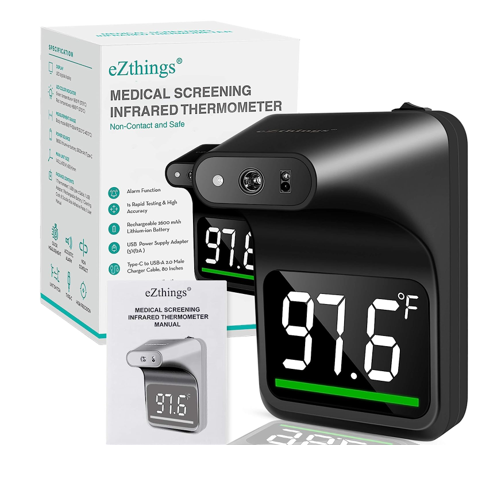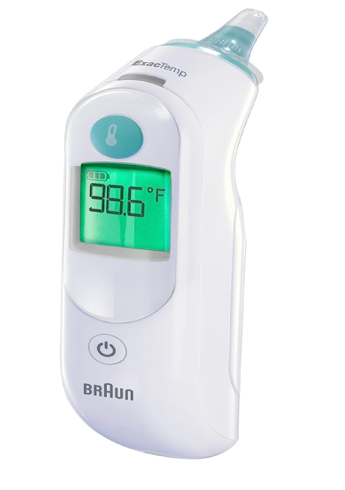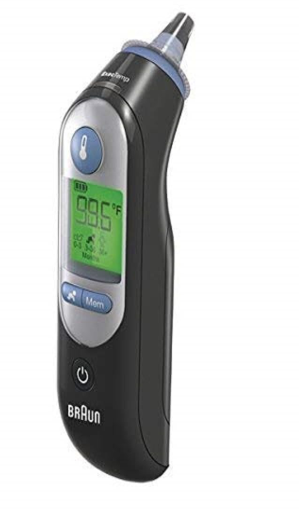Our comprehensive guide on the best electronic thermometers for patients welcomes you to the world of cutting-edge medical technology and precision healthcare. As the demand for accurate temperature measurement rises, these innovative devices have emerged as essential tools for monitoring and ensuring the well-being of individuals.
From contactless infrared thermometers to smart Bluetooth-enabled options, our curated list highlights the most reliable and user-friendly thermometers, empowering patients and caregivers alike with the ability to track body temperature swiftly and accurately, detect fever, and ultimately foster a safer and healthier environment.
What Is A Thermometer?
A thermometer is a medical or scientific instrument used to measure temperature. It is a valuable tool for monitoring body temperature, detecting fever, and assessing environmental or substance temperatures in various contexts.
The two primary types of thermometers are:
Mercury-in-glass thermometer: Traditionally used for clinical applications, it consists of a glass tube filled with mercury, which expands or contracts with temperature changes. The temperature is read from the scale on the glass tube.
Electronic thermometer: A modern alternative, electronic thermometers use sensors, such as thermocouples or infrared sensors, to measure temperature. The readings are displayed on a digital screen, making them easier to read and interpret.
In recent years, electronic thermometers have become more prevalent due to their speed, accuracy, and user-friendly features. Some models offer non-contact measurements, making them convenient and hygienic for use in medical settings.
Thermometers are indispensable tools in healthcare, laboratories, industries, and everyday life, aiding in the accurate assessment of temperature variations for various purposes.
What to Consider When Buying Best Electronic Thermometers for Patients
When buying the best electronic thermometers for patients, consider the following factors to ensure you make an informed and suitable choice:
Accuracy: Look for thermometers that provide precise readings to monitor even slight changes in temperature accurately.
Speed: Choose thermometers that offer fast readings, especially when dealing with restless or young patients who may find it challenging to sit still for extended periods.
Type: Decide between contact and non-contact thermometers. Contact thermometers are typically more accurate for core temperature readings, while non-contact infrared thermometers offer convenience and hygiene benefits.
Age-appropriateness: Ensure the thermometer is suitable for the age group of the patients it will be used on, as some models may have specific guidelines for infants, children, or adults.
Display: opt for thermometers with clear, easy-to-read displays, featuring large numbers and backlight options for better visibility, especially in low-light conditions.
Memory function: Check if the thermometer has a memory storage feature to track previous readings, allowing temperature trends to be monitored over time.
Fever indicator: Look for thermometers with color-coded fever indicators to identify abnormal temperatures quickly, simplifying the interpretation of results.
Battery life: Consider the battery life and power source to ensure the thermometer will be reliable in the end, especially during emergencies.
Calibration: Some thermometers may require calibration to maintain accuracy, so check if the model you choose offers straightforward calibration procedures.
Durability and hygiene: Ensure the thermometer is made of sturdy materials, easy to clean, and has disposable probe covers to prevent cross-contamination.
Brand reputation and reviews: Research the brand’s reputation and read user reviews to gauge the reliability and user satisfaction of the product.
Certifications: Look for thermometers that comply with relevant medical certifications, such as FDA approval, to ensure they meet industry standards.
Additional features: Consider any extra features like a silent mode, fever alarms, or compatibility with smartphone apps for added convenience and functionality.
By carefully considering these factors, you can select the best electronic thermometer that meets your specific needs and guarantees accurate and reliable temperature monitoring for patients.
Best Electronic Thermometers for Patients
-
Welch Allyn 01692-201 SureTemp Plus 692 Electronic Thermometer

Welch Allyn 01692-200 electronic is worth the money thermometer provides more reliable readings with improved accuracy. It takes approximately four to six seconds to read oral temperatures, ten to thirteen seconds to read pediatric axillary and rectal temperatures and twelve to fifteen seconds to read adult axillary temperatures.
Features
- Measures 100 x 59.1 x 39.4 inches
- Weighs 1.72 Pounds
- Digital
- Intuitive operation
- Battery Powered(3 AA)
- Ergonomic design
- Back lit LCD display
- 6 seconds response time
- 60-second pulse timer
- Interchangeable and removable probe
- 4′ Cord and Oral Probe with Probe Well
Pros
- Reusable
- Comfortable to hold
- Easy to use
- Mountable
- Durable
- Location identification capability
- Can count pulses and respirations
- Has security options to help prevent theft
- Has reduced risk of cross-contamination
Cons
- Expensive
-
REED Non-Contact Medical Screening Forehead Thermometer

REED non-contact medical screening forehead thermometer is designed to detect infrared radiations at 5-14um by highly precise infrared sensor. Its high quality sensor plus special calculation and calibration enables this thermometer to take accurate body temperature.
Features
- 2600mAh lithium ion battery
- USB power supply adapter
- 1S rapid tasying
- Acoustic alarm
- Non-contact
- LCD Display
- Tri Color Temperature light
Pros
- High accuracy
- Quick measurement
- Rechargeable
- Portable
- Able to mount on different surfaces or a stand.
- FDA and CE approved
Cons
- Auto off takes long hence drains batteries quickly
-
Braun ThermoScan 6, IRT6515 – Digital Ear Thermometer

This Amazon’s choice Braun ThermoScan 6 (IRT6515) delivers accurate and reliable results, quickly
Features
- White
- Digital
- Pre-warmed tip
- Infrared technology
- Lens filters
- Measures 5.4 x 2.7 x 8.2 inches
- Weighs 10.4 Ounces
- Ear thermometer
- Use 2 AA batteries
- Gives Celsius and Fahrenheit
Pros
- Disposable lens filters
- Gives accurate and reliable results
- Easy to use
- For all ages
- Comes with batteries
- Most recommended brand as per survey
Cons
- Requires you to change the mode every time
-
Exergen temporal artery thermometer – PT# TAT5000

Exergen temporal artery thermometer ensures superior functionality in the most demanding of hospital environments.
Features
- 1 9V batteries required
- Standard model
- White
- Contact thermometer
- Able to switch between Celsius and Fahrenheit
Pros
- Chemically resistant
- High Accuracy
- Meets heavy duty demands
- Can clean or use disposable covers
- Lifetime warranty
- Easy to use
Cons
- Expensive
-
Braun ThermoScan 7 – Digital Ear Thermometer

The Braun ThermoScan 7 comes in handy when checking your loved ones for a fever at home. It features age precision technology for age-adjustable fever guidance, and color-coded display for an easy results interpretation.
Features
- Measures 5.4 x 2.7 x 8.2 inches
- Weighs 10.4 Ounces
- Ear thermometer
- Digital
- Pre-warmed tip
- Infrared technology
- Lens filters
- Use 2 AA batteries
- Gives Celsius and Fahrenheit
Pros
- Easy to use
- For all ages
- Comes with batteries
- Disposable lens filters
- Gives accurate and reliable results
- Most recommended brand as per survey
Cons
- Requires you to change the mode every time
How To Interpret Temperature Readings
Interpreting temperature readings involves understanding the context, the scale used (Celsius, Fahrenheit, Kelvin, etc.), and considering various factors that may affect the temperature measurement. Here are some steps to help you interpret temperature readings accurately:
Understand The Scale
Determine whether the temperature is in Celsius (°C), Fahrenheit (°F), Kelvin (K), or any other scale. Each scale has different reference points and intervals.
Know The Context
Consider the context in which the temperature reading was taken. For example, if it’s an outdoor temperature, weather conditions like sun exposure, wind, and humidity can affect the reading. If it’s a body temperature, consider if it was measured orally, in the ear, or under the armpit, as these can yield slightly different results.
Identify Normal Ranges
Familiarize yourself with typical temperature ranges for different scenarios. For example, the normal human body temperature is around 37°C (98.6°F), but it can vary slightly depending on the individual, time of day, and activity level.
Assess The Significance
Determine whether the temperature reading is within the expected range or if it falls outside the normal range. Abnormal readings might indicate fever, hypothermia, or other health issues.
Look For Patterns
If you have multiple temperature readings taken over time, look for patterns or trends. This can help identify any changes or fluctuations that may require attention or investigation.
Consider The Device Used
Different temperature measuring devices (thermometers) can have varying levels of accuracy. Digital thermometers, infrared thermometers, and mercury-based thermometers might have different precision levels, so consider the reliability of the device used.
Seek Medical Advice
If the temperature reading is for health-related concerns, consult a healthcare professional for proper interpretation and advice. Self-diagnosing based on temperature readings alone can be misleading.
Consider Calibration
If the accuracy of the temperature reading is critical, make sure the measuring device is properly calibrated. Regular calibration ensures the device is providing accurate readings.
Understand Absolute Zero
In Kelvin scale, absolute zero (0 K) is the point where there is zero thermal energy. Temperatures in Kelvin cannot be negative. Celsius and Fahrenheit scales are relative to their respective zero points, so they can have negative values.
Take Environmental Factors into Account
Be aware of environmental factors that can affect temperature readings, such as altitude, surrounding objects, or direct sunlight, especially when measuring outdoor or non-standard temperatures.
How Electronic Thermometers Work
Electronic thermometers work based on the principle of temperature-dependent electrical properties of certain materials. The most common type of electronic thermometer uses a thermistor or a thermocouple as the temperature sensor.
Here is how they work:
Thermistor-based thermometers
Thermistors are semiconductor devices with electrical resistance that changes with temperature. They are made from materials like ceramic or polymer, which exhibit a predictable and repeatable change in resistance as the temperature changes.
When a current passes through the thermistor, its resistance is measured, and the electronic circuit converts this resistance into a temperature reading, which is then displayed on the screen.
Thermocouple-based thermometers
Thermocouples consist of two different metal wires joined at one end to form a junction. When this junction is exposed to a temperature gradient, it generates a voltage proportional to the temperature difference.
The electronic circuit measures this voltage and, through calibration, translates it into a temperature reading, which is displayed digitally.
In both cases, the electronic thermometer contains a microcontroller or microprocessor that processes the electrical signals from the temperature sensor.
This microcontroller performs necessary calculations, calibration, and temperature conversions to provide an accurate temperature reading. The result is then displayed on a digital screen in a format that is easy to read and interpret.
Some modern electronic thermometers may also incorporate infrared sensors for non-contact temperature measurements. Infrared thermometers work by detecting the infrared radiation emitted by the object or body being measured and then convert it into a temperature reading using complex algorithms.
Overall, electronic thermometers offer fast, accurate, and user-friendly temperature measurements, making them widely used in medical settings, industries, and homes.
Benefits of Having Best Electronic Thermometers for Patients
Having the best electronic thermometers for patients offers several significant benefits, making them essential tools in healthcare and beyond:
- Provide precise temperature measurements, enabling healthcare professionals to make accurate diagnoses and monitor patient conditions effectively.
- Offer rapid readings, saving valuable time and minimizing patient discomfort, especially in critical situations or when dealing with restless or young patients.
- Many electronic thermometers now offer non-contact infrared options hence reducing the risk of cross-contamination and promoting hygiene, especially in infectious disease settings.
- Digital displays with large, clear numbers make it easy for healthcare providers and patients to interpret temperature readings quickly and accurately.
- The best electronic thermometers often come with memory storage, allowing for the tracking of previous readings and temperature trends over time, aiding in the assessment of a patient’s health progress.
- Some thermometers have color-coded fever indicators, making it simple to identify abnormal temperatures and potential fever symptoms at a glance.
- Electronic thermometers are suitable for use on patients of all ages, from infants to adults, providing a versatile solution for temperature monitoring in various healthcare settings.
- Some advanced electronic thermometers can connect to smartphones or other devices via Bluetooth or other technologies, enabling easy data sharing with healthcare professionals or integration with health tracking apps.
- Electronic thermometers with disposable probe covers or contactless features reduce the risk of transmitting infections and promote a safer healthcare environment.
- Well-regarded electronic thermometers from reputable brands undergo rigorous testing and calibration, ensuring their reliability and consistency in temperature measurement.
- Electronic thermometers are often compact, portable, and easy to use, making them suitable for home use as well as professional medical settings.
- Some electronic thermometers offer continuous monitoring capabilities, providing real-time temperature data for patients in critical conditions, ensuring prompt medical interventions when needed.
You may also like
best hearing aids in the market for senior citizens
6 best portable oral irrigators
8 best medical scooters for broken foot
FAQs on Best Electronic Thermometers for Patients
How accurate are electronic thermometers compared to traditional mercury thermometers?
Electronic thermometer is generally as accurate, if not more accurate, than traditional mercury thermometers. They offer precise temperature readings and are widely used in medical settings due to their reliability.
Are contactless infrared thermometers safe and accurate for measuring body temperature?
Yes. They measure the infrared radiation emitted by the body’s surface, providing fast and hygienic temperature readings without physical contact.
Can electronic thermometers be used for all age groups, including infants and children?
Yes, most electronic thermometers are suitable for use on patients of all ages, including infants, children, and adults. However, some models may have specific guidelines for age-appropriate use.
Do electronic thermometers require calibration, and how often?
Some electronic thermometers may require calibration periodically to maintain accuracy. The frequency of calibration varies depending on the model and manufacturer. It is essential to follow the manufacturer’s instructions for calibration.
Can I use an electronic thermometer for measuring the temperature of objects or liquids, or is it designed only for body temperature?
Many electronic thermometers can be used for measuring the temperature of objects and liquids as well as body temperature. However, it is crucial to check the thermometer’s specifications to ensure it is suitable for the intended use, as some models may be designed specifically for body temperature measurement.
Conclusion
In summary, the best electronic thermometers for patients offer accuracy, speed, and convenience, facilitating timely and informed medical decisions, enhancing patient care, and contributing to a safer and healthier healthcare environment overall.
Through our exploration of the best options available, we have witnessed the seamless integration of precision engineering, user-friendly interfaces, and advanced features that empower patients and caregivers to take control of their health.
Whether it is, the convenience of contactless measurements or the connectivity offered by smart thermometers, these cutting-edge devices have proven to be invaluable assets in promoting early detection of illnesses, enhancing patient care, and ensuring a safer and healthier future for all.
Lastly, with the continued evolution of technology, we can only anticipate further advancements in electronic thermometers, solidifying their position as essential tools in the modern medical landscape.

